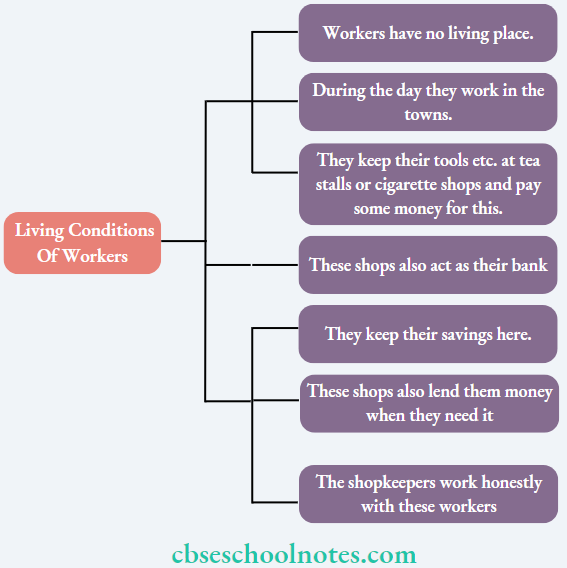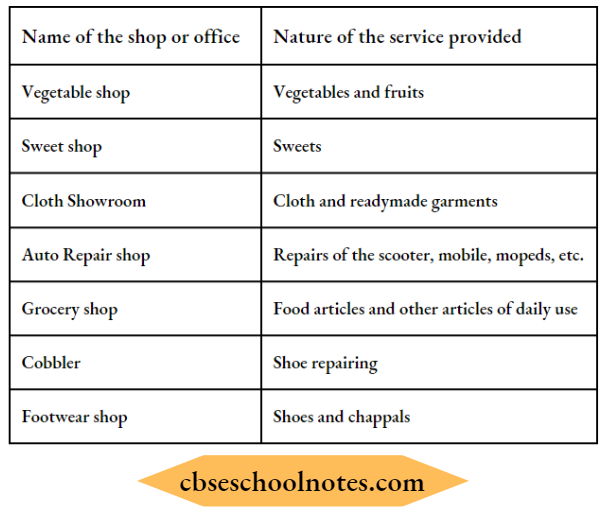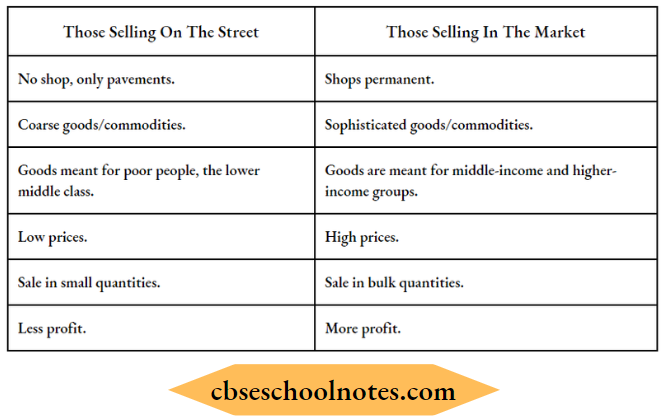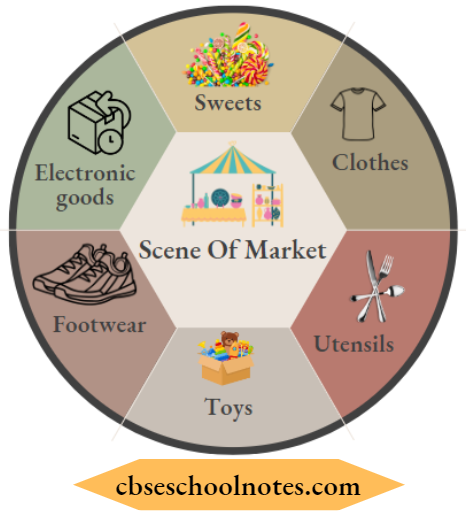Urban Livelihoods Exercises
Question 1. Read and discuss the following description of the living conditions of workers who come to the labor chowk.
Most workers that we find at the Labor Chowk cannot afford permanent accommodation and so sleep on pavements near the Chowk, or they pay ₹ 6 a night for a bed at a Jicarby night shelter run by the Municipal Corporation.
To compensate for the lack of security, local tea and cigarette shops function as banks, moneylenders, and safety lockers, all rolled into one. Most workers leave their tools at these shops for the night for safekeeping and pass on any extra money to them. The shopkeepers keep the money safe and also offer loans to laborers in need.
Source: Aman Sethi, Hindu On-line
Answer:

Question 2. Complete the following table and discuss how their work is different:
Answer:

Question 3. In what ways is a permanent and regular job different from a casual job?
Answer:

Read and Learn More CBSE Solutions For Class 6 Social Science
Question 4. What benefits does Sudha get along with her salary?
Answer:
Sudha gets the following benefits along with her salary:
- Pension fund with interest on savings.
- Hobdays: Sundays National Holidays, and annual leave.
- Medical Facilities: Medical reimbursement, medical allowance for her family; medical leave with pay (up to some amount).

Question 5. Fill in the following contents to show the services provided by people in the markets which you visit frequently.
Answer:

Question 6. Discuss
1. What do you see in this illustration?
Answer:
In This Illustration We See The Following:

2. Now compare the work that people in this illustration are doing with the work that people do in rural areas.
Answer:

Comparison Between The Work Of Rural Areas And That Of Urban Areas:
3. Some parts of the city are different from others. What differences do you notice in this illustration?
Answer:
Some parts have large buildings, towers, and shopping malls. – Other parts are low-income people areas.
Question 7. There are more than five thousand towns and twenty-seven big cities in India. Big cities like Chennai, Mumbai, Delhi, Kolkata, etc. have more than a million people living and working here. They say that (the city never sleeps!’ Let’s visit one and find out about the work people do in the city.
- Are they employed by someone or are they self-employed?
- How do they organize themselves?
- Do they have similar employment and earning opportunities?
Answer:
The people do the following work in the cities.
- They drive auto-rickshaws and rickshaws
- They carry loads.
- They sold plants and saplings.
- They sell newspapers.
- They run shops.
- They clean the roads.
- Work in offices.
- Most of them are self-employed. Some have been employed by the Municipal Corporation as sweepers, and road cleaners. Some work in offices.
- They organize themselves mutually, through advertisements, posters rallies, protests, etc.
- No, they have different employments and different earning opportunities.
Question 8. Bachchu Manjhi — A Cycle-Rickshaw Puller:
1. Why did Bachchu Manjhi come to the city?
Answer:
Bachchu Manjhi came to the city to earn more income for his family.
2. Why can’t Bachchu Manjhi live with his family?
Answer:
Bachchu Manjhi cannot live with family as he does not have any room to stay in. Otherwise, also, the cost of living for the whole of his family is very high in the city, as, compared to a village.
3. Talk to a vegetable vendor or hawker and find out how they organize their work, their way of preparing, purchasing, selling, etc.
Answer:
- The vegetable vendors or hawkers organize their work in the following manner:
- Vendors purchase vegetables or groceries from the wholesale market.
- Vendors arrange them on the trolley cycle.
- Vendors sell their goods by calling passersby loudly.
4. Bachchu Manjhi has to think twice before taking a day off from work. Why?
Answer:
Bachchu Manjhi has to think twice before taking a day off from work Because on that day he would not earn anything. But he will have to spend?
Question 9. Harpreet and Vandana Business persons
1. Why did Harpreet and Vandana start a showroom?
Answer:
Harpreet and Vandana started working in their own shop completing their college education.
2. What do they have to do to run the showroom?
Answer:
They Had To:
- Purchase garments from different cities and states.
- Put them in showcases.
- For sale, give advertisements in different newspapers, radio, etc.
3. Talk to a shop owner in a market and find out how he plans his work.
Answer:
By talking to a businessman, his version was:
- He took the showroom oh rent.
- Now he wants to purchase it.
- Earlier he purchased a house in nearby apartments.
- He has already purchased a car.
The showroom running is based on the following activities.
- He buys different things from different places.
- He advertises his products in the newspapers, radio, and TV channels.
4. Have there been any changes in his business in the past twenty years?
Answer:
During the last 20 years, things have changed. Before he sold clothes. Now he sells readymade garments as the fashion is of readymade garments, because
- They are cheaper.
- A variety of garments are available.
- Time is also saved.
5. What are the differences between those who sell and those in the market?
Answer:
Differences between those who sell on the street and those in the market.

Question 10. Discuss
1. Why do you think small workshops and factories employ casual workers?
Answer:
Small workshops and factories employ casual workers because of the following reasons:
- Small workshops and factories work seasonally. During lean periods they do not work.
- They are not rich enough to pay salaries for the lean periods. (Rich workshop owners, also do not want to pay salary for lean period.)
2. Describe the working conditions of people like Nirmala keeping in mind the following: working hours, conditions in the workplace, earnings, and the days of work available.
Answer:
Working conditions of people like Nirmala:
- Workers have to work for long hours.
- Their work starts at 9 a.m. and finishes at 10.30 p.m. or even later.
- They are paid only Rupees 80 per day for eight hours and an extra ₹40 for working late hours.
- They have no bargaining power.
- They are all casual workers as they work only from December to April. After this period they have to move to other work or no work.
3. Would you say that domestic workers like housemaids are also casual workers? Why? Describe the workday of one such woman detailing the work she does in other peoples’ houses.
Answer:
Yes, we say domestic workers like housemaids are also casual workers. They can work as long as their employer wants.
Workday Of One Such Woman: Saifali works as a domestic worker
- She washes utensils, cleans the houses, and keeps the children.
- Her work starts at 7 a.m. and finishes at 9 p.m.
- Her wages are ₹10,000 per month.
- She also takes food and refreshments in the house.
- She also does chowkidari of the house during the absence of the owners.
- Saifali is very honest. She works in the house as she does in her own house.
Urban Livelihoods Very Short Answer Type Questions
Question 1. How much percentage of people work on the streets of Ah Mod Ah ad?
Answer:
According to a survey, 12% of all the workers in the city of Ahmedabad work on the streets.
Question 2. Describe the scene of the factory area.
Answer:
Factory Area
- The area was full of small workshops.
- There are so many workshops.
- In one workshop, people worked on sewing machines in a small room. They were stitching clothes.
Question 3. Why were vegetable vendors busy in the morning?
Answer:
- Vendors were busy arranging tomatoes, carrots, and cucumbers in baskets; so that people could see, what they were selling.
- Their main sale is in the morning.
Question 4. What people were doing around newspaper sellers?
Answer:
On the pavement, a person was selling newspapers. Everyone wanted to read the newspaper. So a small crowd was there around newspaper sellers to read the news for free or want to purchase the newspaper.
Question 5. What the cobbler and barber were doing?
Answer:
- The cobbler was sitting under a tree. He was taking his tools out of his small tin box.
- Next to the cobbler, a barber had begun his work. He already had a customer.
Question 6. What do the women have in their carts?
Answer:
- All kinds of plastic bottles
- Boxes
- Hairpins
- Clips, etc.
Question 7. Were hawkers allowed to go to all parts of the city?
Answer:
No, there were some parts of the city, where they were not allowed to go.
Question 8. What is provident fund?
Answer:
- A provident fund is a saving of workers.
- A certain amount is deducted from the salary of the worker.
- The same amount is also paid by the employer. Both these amounts are deposited with the government. The government gives annual interest on it. He can withdraw the amount when he requires it.
Urban Livelihoods Short Answer Type Questions
Question 1. How do vendors people organize their work?
Answer:
Vendors Organise Their Work In The Following Manner:
- Vendors plan how much to purchase.
- Vendors plan where to purchase.
- Vendors plan where to set up their shops.
Question 2. Write 5 lines about vendors.
Answer:
- Their Shops Are Temporary Structures:
- Sometimes some boards -Canvas sheets hung on four poles
- Plastic sheets spread on the pavements.
- These people have no security.
- Police can remove their shops at any time.
- Vendors, who sell food items, sell their goods (food items), already prepared at home like snacks, foods, colas, etc.
Question 3. What is being done now for the hawkers/street vendors?
Answer:
The work of hawker s/street vendors has been recognized as important as they serve low-income purchasers.
- Previously hawkers were not allowed to sell their articles on the streets.
- Now hawking zones have been suggested for the hawkers.
- Vendors have been made members of the committees which think about their welfare.
Question 4. Describe the new garments showroom.
Answer:
New Garment Showroom:
- The showroom had three floors.
- Each floor had different kinds/types of clothes.
- The third floor had clothes for girls.
Question 5. Describe the scene in the buses that go to factory areas.
Answer:
Scene In The Buses:
- The buses are crowded.
- At every bus stop, more and more people boarded the bus.
- The writer and her cousin stood in a comer so that they could not be squashed.
- They felt surprised at how people travel daily in such a crowded state.
Question 6. Describe the scene of the market.
Answer:
Because of the festival season, the market was crowded.
There Were Many Shops.

Question 7. From which places does Vandana’s showroom buy materials?
Answer:
Showroom Buy Materials From Mumbai, Ahmedabad, Ludhiana, Tripura
- Some material also comes from Noida and Gurugram, (towns near Delhi).
- Some dresses they buy from foreign countries also.
Question 8. Who employs a businessman?
Answer:
- They are not erupted by anyone.
- Instead, they give employment to a number of other people.
- These people are employed as helpers and supervisors.
Question 9. What is a shift system?
Answer:
- One worker works on one machine for 12 hours, i.e. 1st shift.
- On the same machine, other workers work, for the next 12 hours i.e., the 2nd shift.
Urban Livelihoods Long Answer Type Questions
Question 1. Why do laborers gather at the Labour chowk? What are they called?
Answer:
- The laborers gather at the labor chowk to find jobs on a daily wage basis.
- These laborers do the following work:
- Carpenter
- Masons
- As helpers to masons.
- Work at construction sites as a laborer.
- Lifting loads.
- Unloading trucks in the market.
- They also build roads.
- These laborers are called casual workers.
- When any person requires any of their services, he contacts them and gets his job on payment of the service.
Question 2. Given an account of Sudh’s duties.
Answer:
Sudha works in a company as a marketing manager. Her office is surrounded by tall buildings.
- She is the marketing manager of a company, manufacturing biscuits.
- The biscuit factory is outside the city
- She supervises 50 sales persons. They get orders and payments from shopkeepers.
- She has divided the city into six Zones or regions.
- She works for six days.
- She meets each salesperson once a week.
- She checks their progress and discusses their problems.
- She plans sales for the whole city. She often travels and works late in the evenings.
Question 3. Write a short/brief note on Vail Centres’.
Answer:
Call Centres are providing new job opportunities to people in cities.
- The call center is a centralized office to attend to complaints and queries of people.
- The issues can be regarding goods purchased, banking, ticket booking, etc.
- They are set up in large rooms with workstations including computers, telephones, etc. So many people are working in the same room.
- India has become a major center for call centers.
- Many foreign companies have hired services from Indian Call Centres. As wages are very low in India as compared to their own country, so they save money by this.
Urban Livelihoods Multiple Choice Questions
Choose The Correct Answer:
Question 1. Who is Bachchu Manjhi?
- Engineer
- Dentist
- Rikshaw-puller
- Teacher
Answer: 3. Rikshaw-puller
Question 2. How much does Bachchu
- Rupees 50
- Rupees 100
- Rupees 150
- Rupees 200
Answer: 2. Rupees 100
Question 3. The life of people in urban areas is ________ than the rural area.
- Slower
- Faster
- Both 1 and 2
- None of these
Answer: 2. Faster
Question 4. If we feel a problem in our teeth, where should we go?
- To a physician
- To an orthopaedic
- To veterinary
- To dentist
Answer: 4. To dentist
Question 5. Where are readymade clothes sold?
- At garments shop
- At shoe shop
- At the chemist’s shop
- At none of these
Answer: 1. At garments shop
Question 6. What does Vandana do?
- Saleswomen
- Dress designer
- Nurse
- Peon
Answer: 2. Dress designer
Question 7. Which of the following places are near Delhi?
- Mumbai and Goa
- Kullu and Manali
- Noida and Gurugram
- Panipat and Kurukshetra
Answer: 3. Noida and Gurugram
Question 8. Where do laborers on daily wages wait with their tools?
- Labour Chowk
- Ramlila ground
- Cinema Halls
- None of these
Answer: 1. Labour Chowk
Question 9. Where does Sudha work?
- In an office
- As a person in a shop
- In a factory
- All of these
Answer: 1. In an office
Question 10. What benefits does Sudha get along with her salary?
- Savings for old age
- Gets off on Sundays and national holidays
- Medical facilities
- All of these
Answer: 4. All of these
